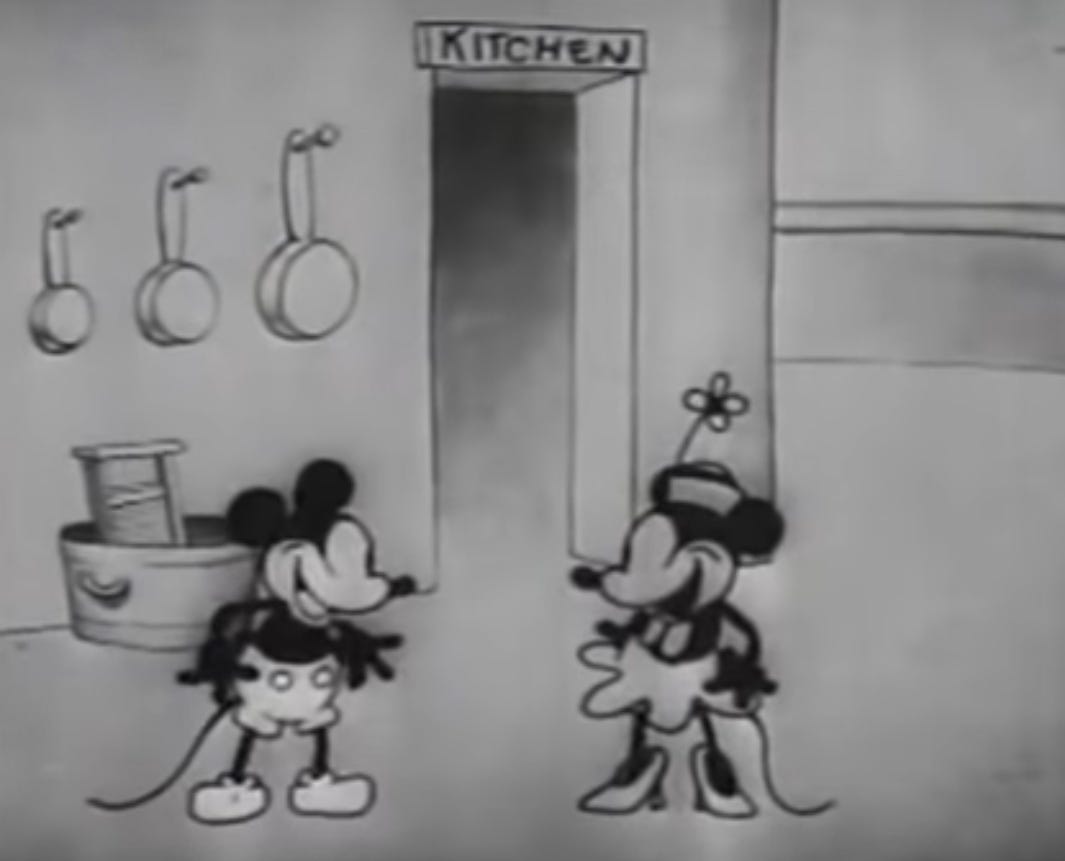Nov. 18 marked the 95th anniversary of Walt Disney and Ub Iwerks’s 1928 animated short “Steamboat Willie”—and thus the screen debut of one of the most popular and iconic fictional characters in history, Mickey Mouse.
Walt Disney was a pioneer in so many ways, a genius who spawned whole new industries of animation, theme parks, and more. His scrappy, cheerful animated mouse became so popular so quickly that it is rumored “Mickey Mouse” was used as a password for certain parts of the 1944 WWII D-Day invasion of Normandy! But not everyone knows how Mickey Mouse, and his almost equally iconic sweetheart Minnie Mouse, got their start.
Walt’s brother Roy said that Walt was inspired to do a sound cartoon after seeing the first “talking” movie, the 1927 film starring Al Jolson called “The Jazz Singer.” It was revolutionary at the time to sync up moving pictures with sounds! “The Jazz Singer” made history, but so did Walt—his “Steamboat Willie” would be the first animation with synchronized sound. Walt Disney himself was the voice for Mickey Mouse, Minnie Mouse, and the parrot in the animated short, according to Disney Fandom. At the first experimental screening of the then-unfinished “Steamboat Willie,”1 with Walt Disney and his crew performing the sounds as the short played, the little audience of family and friends were enthralled. Even if Disney and crew didn’t hit every note right at that screening, and even if the sound was a little off with the animation, everyone was excited by this totally new type of motion-sound entertainment! Walt recalled:
“When the picture was half finished, we had a showing with sound. A couple of boys could read music and one of them, Wilfred Jackson, could play a mouth organ [harmonica]. We put them in a room where they could not see the screen and arranged to pipe their sound into the room where our wives and friends were going to see the picture. The boys worked from music and sound effects score. After several false starts, sound and action got off with the gun. The mouth organist [harmonica player] played the tune; the rest of us in the sound department blamed tin pans and blew slide whistles in the beat. The synchronism was pretty close. The effect on our little audience was nothing less than electric. They responded almost instinctively to this union of sound and motion. I thought they were kidding me. So they put me in the audience and ran the action again. It was terrible, but it was wonderful! And it was something new!”
That’s partly where Walt Disney’s genius lay—in creating something totally new. There was animation before Disney, but no one had ever done it so well. And when American audiences saw Mickey and Minnie happily scurrying and hopping about on screen, making noises and music, the effect on many of them was “electric” too. It would still be almost a decade before the first full-length animated film, Disney’s 1937 “Snow White and the Seven Dwarfs,” would make its debut, but Mickey and Minnie Mouse and Disney’s motion-sound animation had captured the hearts of Americas—and eventually, people all over the world.
On Nov. 18, 1928, Mickey and Minnie Mouse came to the screen in “Steamboat Willie.” Below you can see part of the original script from the short, found in Walt’s desk and made public by the Walt Disney Company; you can also watch the short itself.
Before the short’s debut, according to the BBC, Walt Disney was staring financial ruin in the face (as he was several times throughout his early life). Walt was never a good businessman, and in this case he’d lost both most of his staff and the rights to his character “Oswald the Lucky Rabbit.” But Disney, Ub Iwerks, and Les Clark got together to work on Walt’s idea—an idea which he got while on a long train ride—for “a sympathetic mouse who navigates his way through a series of comic misadventures.”
Walt wanted the character to be named “Mortimer,” the name of a pet mouse he temporarily had as a child, but his wife convinced him to change it to “Mickey” instead. But neither of the first two Mickey Mouse cartoons inspired enough interest to obtain a distributor. “Steamboat Willie,” however, was so popular that it was quickly more famous than the feature film it was just supposed to precede! BBC:
“Steamboat Willie premiered in New York and its seamless marriage of sound and visuals was an instant sensation: glowing reviews soon began appearing in the press and people flocked to see it. Its innovative animated storytelling thrilled audiences, with cinema-goers often clamouring for the projector to delay the start of the feature film, so they could watch Steamboat Willie again. Disney quickly capitalised on the character's popularity with more adventures, with Walt himself going on to provide the voice of Mickey…Steamboat Willie's success ushered in a new era of cartoon storytelling. It set the stage for Walt Disney's domination of the medium, which would see Disney creating the Oscar-winning Snow White and the Seven Dwarfs in 1937.”
According to Rebecca Cline, the director of the Walt Disney Archives, Walt believed Mickey exemplified the “Everyman” (at least as the Everyman was in the America of his time): often facing failure and setbacks, but always getting up again with the optimistic belief that this time he’ll succeed. “When asked why Mickey was so popular, Walt once said, ‘when people laugh at Mickey Mouse it’s because he’s so human; and that is the secret of his popularity.’”
Disney Fandom: “The title is a parody of the Buster Keaton film Steamboat Bill Jr.”








You know I dig some Disney history! Good stuff.